Since I dive with seabirds and often have fine opportunities to observe them in and under the water, photography of seabirds holds a certain appeal and I do pursue it from time to time. However, there is really only one bird that I have been able to photograph well, primarily because it is big, slow and I can get close to it: the pelican. Over the years I have pursued pelican photography as a means to practice and stay sharp with whatever topside equipment I am using at the moment. In particular, I will shoot California brown pelicans in La Jolla. These birds are magnificient flyers found in a beautiful setting (La Jolla is the jewel of San Diego), have photogenic details, and honestly acquiring good photos of them is quite simple for any halfway experienced wildlife photographer.
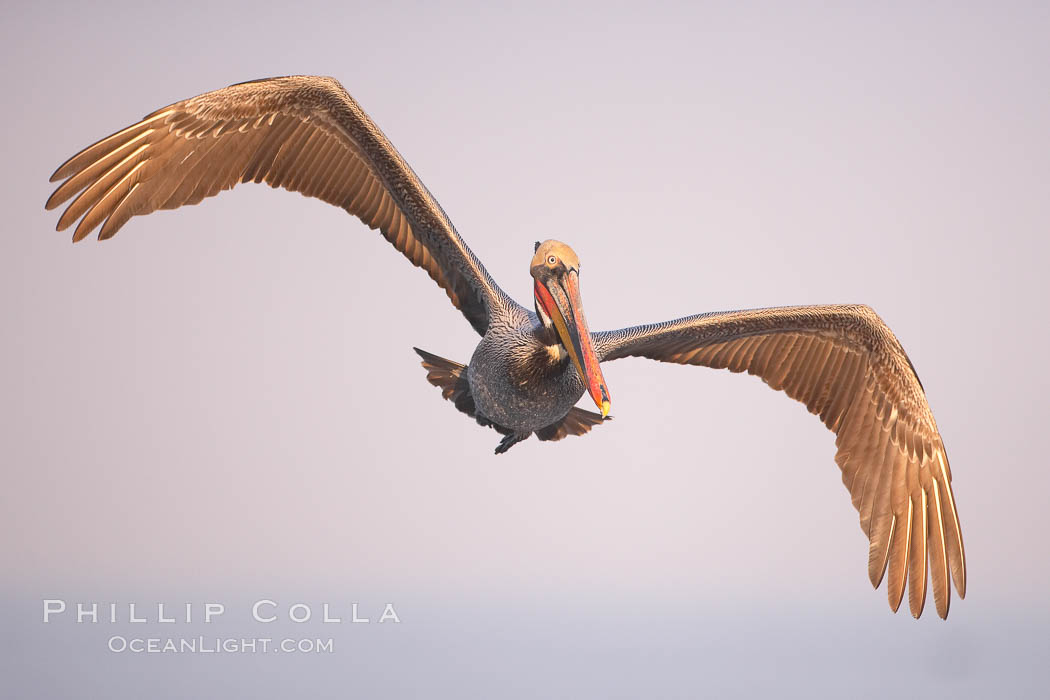
Brown pelican in flight. The wingspan of the brown pelican is over 7 feet wide. The California race of the brown pelican holds endangered species status. In winter months, breeding adults assume a dramatic plumage.
Image ID: 15122
Species: Brown pelican, Pelecanus occidentalis, Pelecanus occidentalis californicus
Location: La Jolla, California, USA
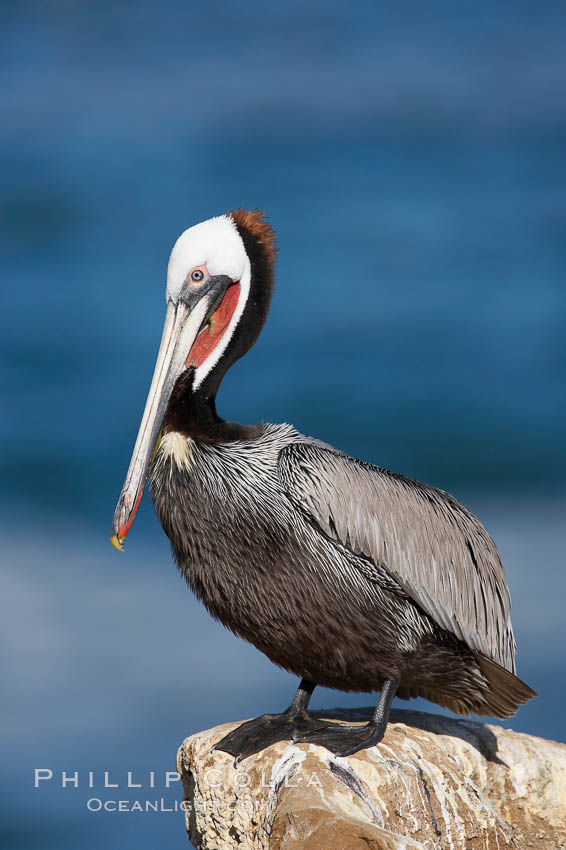
Brown pelican. This large seabird has a wingspan over 7 feet wide. The California race of the brown pelican holds endangered species status, due largely to predation in the early 1900s and to decades of poor reproduction caused by DDT poisoning. In winter months, breeding adults assume a dramatic plumage with brown neck, yellow and white head and bright red gular throat pouch.
Image ID: 15123
Species: Brown pelican, Pelecanus occidentalis, Pelecanus occidentalis californicus
Location: La Jolla, California, USA
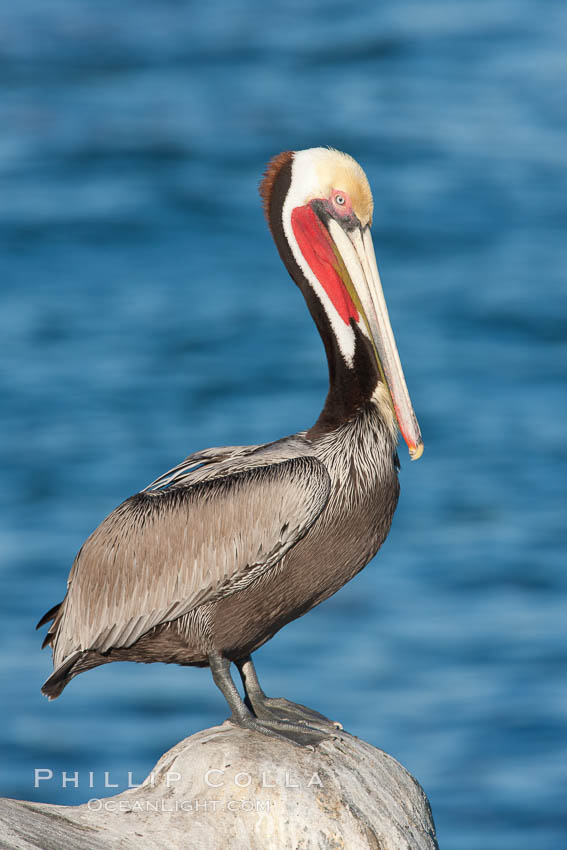
California brown pelican, showing characteristic winter plumage including red/olive throat, brown hindneck, yellow and white head colors.
Image ID: 26470
Species: Brown pelican, Pelecanus occidentalis californicus
Location: La Jolla, California, USA
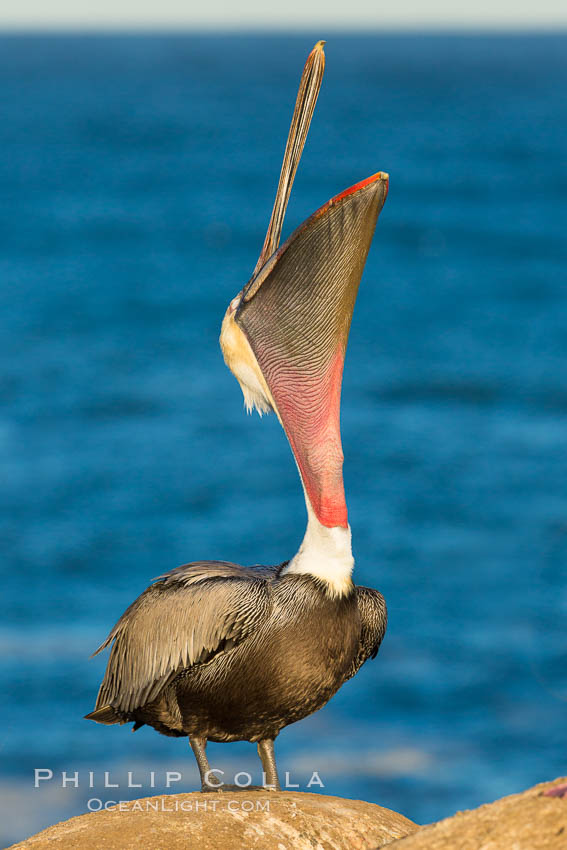
California Brown Pelican head throw, stretching its throat to keep it flexible and healthy.
Image ID: 28347
Species: Brown pelican, Pelecanus occidentalis, Pelecanus occidentalis californicus
Location: La Jolla, California, USA
La Jolla, California is a superb location to observe and photograph the California race of the brown pelican (Pelecanus occidentalis californicus). The cliffs above the La Jolla caves, also known as Goldfish Point, have been an established resting place for brown pelicans for many years. In the 80’s and 90’s when I would visit La Jolla for a morning dive or swim but found the water conditions not to my liking, I would instead pay the pelicans a visit and spend time photographing them. In those days I would be the only person watching them, to the point that if I was patient and moved carefully I would eventually find myself among them, surrounded, with great ops using only an 80-200mm lens. I rarely encountered another photographer. These days, however, the word is out on this opportunity among bird lovers, since it is now typical to find groups of photographers lined up with huge lenses trained on the birds, some of which appear to be workshops or photography classes. Winter is a particularly good time to photograph brown pelicans as they assume their breeding plumage: a striking dark brown neck to contrast with white and yellow head feathers and deep red-orange throat pouch below the bill. Mornings work well, since the pelicans can be photographed in flight, arriving from their morning foraging runs over the ocean to land on the bluff, as well as resting and preening on the guano-covered knobs of rock at the top of the cliffs.
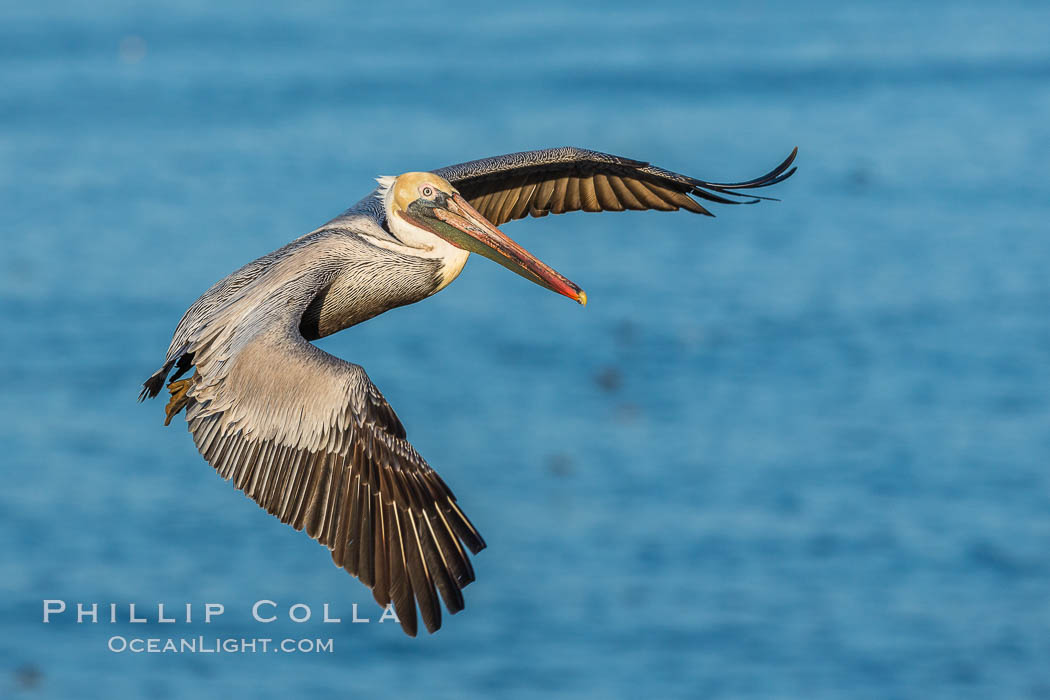
Brown pelican in flight. The wingspan of the brown pelican is over 7 feet wide. The California race of the brown pelican holds endangered species status. In winter months, breeding adults assume a dramatic plumage.
Image ID: 28328
Species: Brown pelican, Pelecanus occidentalis, Pelecanus occidentalis californicus
Location: La Jolla, California, USA
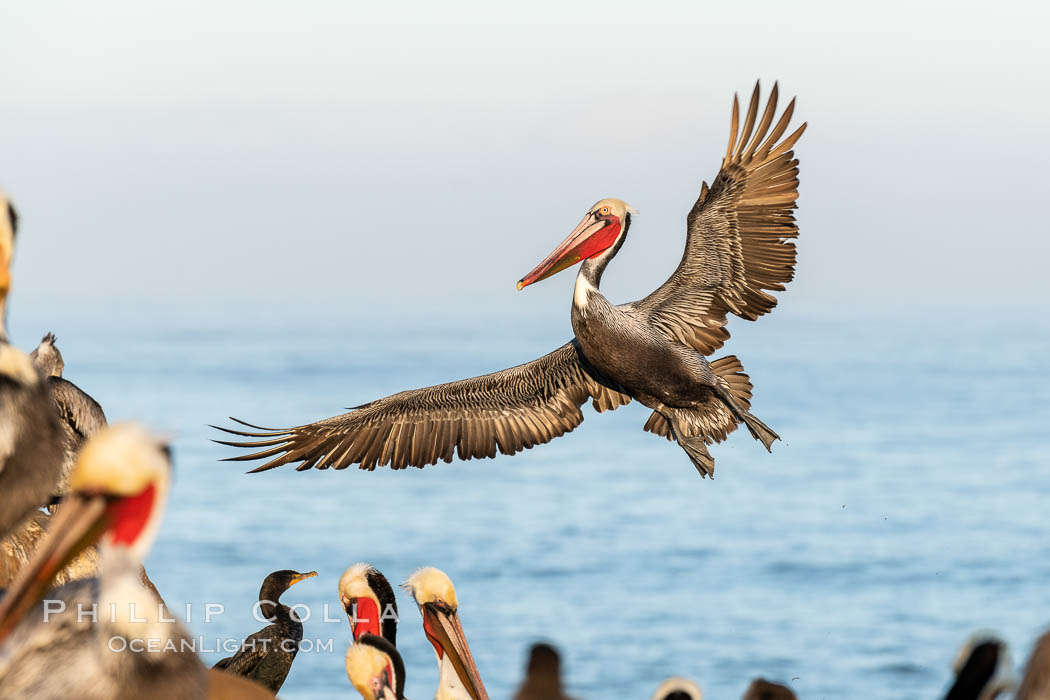
California brown pelican in flight, spreading wings wide to slow in anticipation of landing on seacliffs. Note the classic winter breeding plumage, with bright red throat, yellow and white head and neck, and brown hind neck.
Image ID: 36679
Species: Brown pelican, Pelecanus occidentalis, Pelecanus occidentalis californicus
Location: La Jolla, California, USA
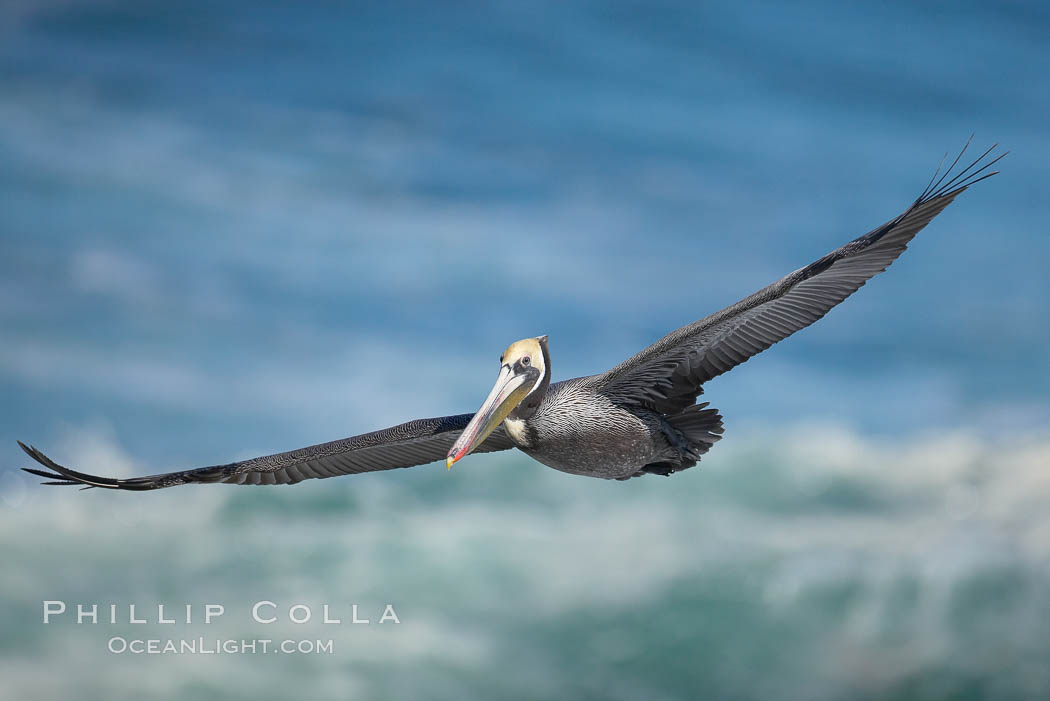
Brown pelican in flight. The wingspan of the brown pelican is over 7 feet wide. The California race of the brown pelican holds endangered species status. In winter months, breeding adults assume a dramatic plumage.
Image ID: 15125
Species: Brown pelican, Pelecanus occidentalis, Pelecanus occidentalis californicus
Location: La Jolla, California, USA
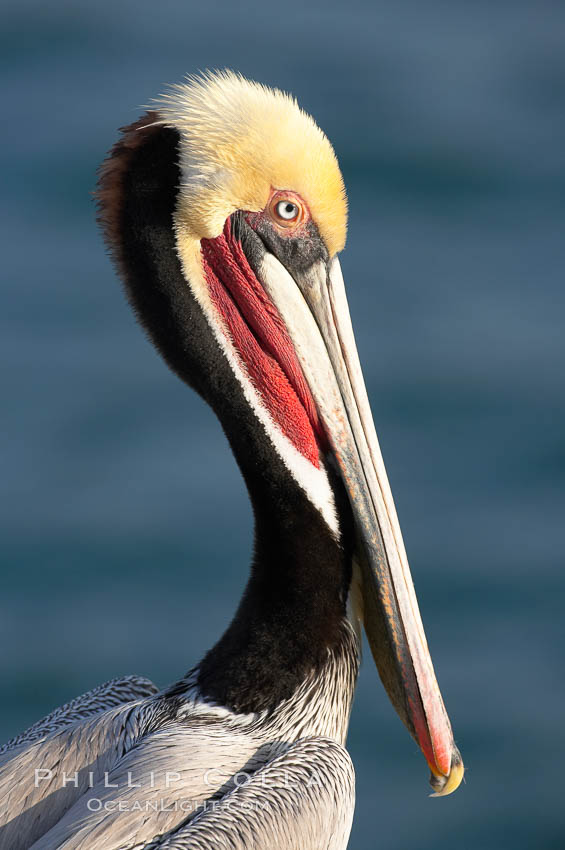
Brown pelican. This large seabird has a wingspan over 7 feet wide. The California race of the brown pelican holds endangered species status, due largely to predation in the early 1900s and to decades of poor reproduction caused by DDT poisoning. In winter months, breeding adults assume a dramatic plumage with brown neck, yellow and white head and bright red gular throat pouch.
Image ID: 15128
Species: Brown pelican, Pelecanus occidentalis, Pelecanus occidentalis californicus
Location: La Jolla, California, USA
Brown pelicans inhabit coastal areas of North and South America, frequenting lagoons, sand flats, cliffs, marinas, piers and waterfronts. While they were classified as endangered throughout their range in 1970, the Atlantic coast population status was no longer considered endangered by 1985 (although the other regions are still.) Brown pelicans are rarely seen inland. The brown pelican is a large bird, reaching 4 ft. in length, weighs about 9 lbs. and has a wingspan over 7 ft. It is characterized by an enormous bill, longer than its head. Pelicans are superb divers, plummeting into the sea to grasp mouthfuls of small fish, requiring about 4 lbs. of fish each day to thrive. The skin pouch suspended from the lower bill holds as much as 3 gallons of water, and is used to trap and hold prey until the water can be released through the side of the mouth, at which time the bill is tipped up and the prey is swallowed. (The skin pouch also offers a way for the pelican to thermoregulate, in other words, cool itself during hot spells.) It should be noted that scientific studies show that pelicans do not compete with commercial fishing interests, in fact pelicans pursue species of fish not desired by the commercial fishing industry.
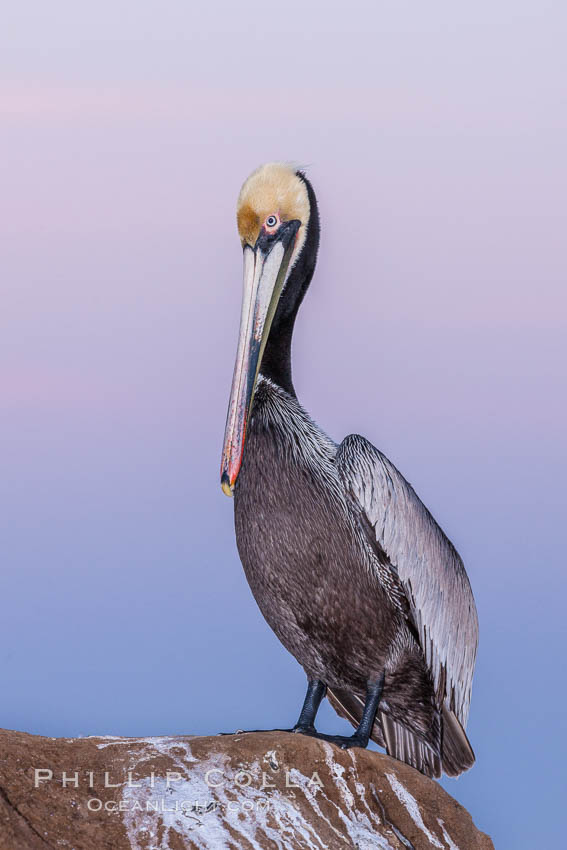
California brown pelican, portrait in pink-purple predawn light, rests on sandstone seabluff. The characteristic mating plumage of the California race of brown pelican is shown, with red gular throat pouch and dark brown hindneck colors.
Image ID: 23646
Species: Brown pelican, Pelecanus occidentalis, Pelecanus occidentalis californicus
Location: La Jolla, California, USA
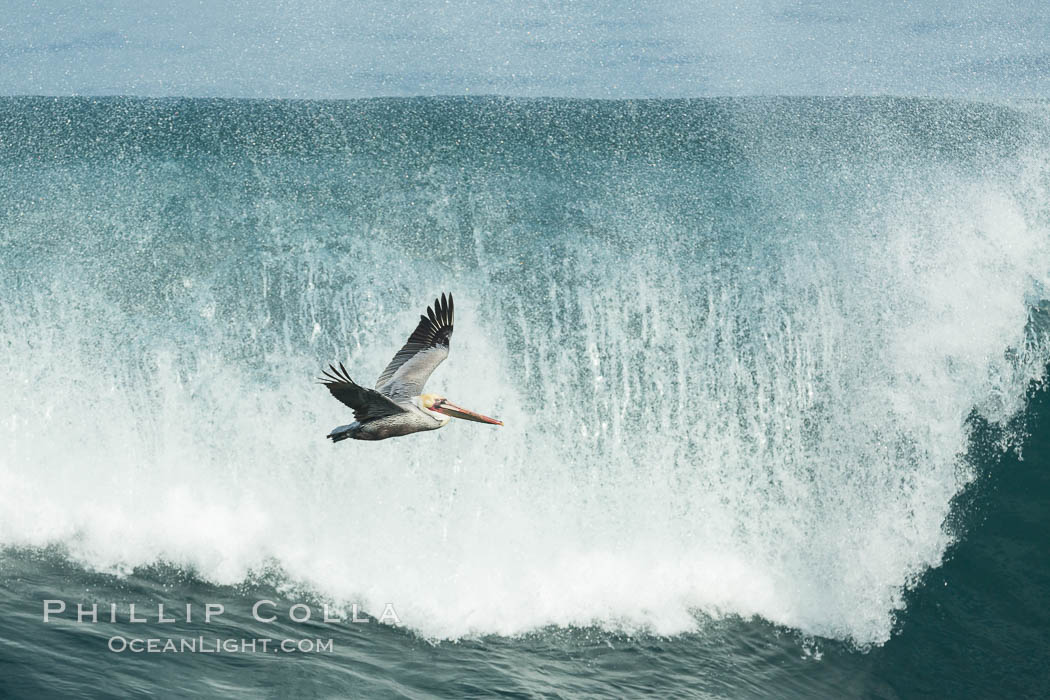
Brown pelican flying over waves and the surf.
Image ID: 30193
Species: Brown pelican, Pelecanus occidentalis, Pelecanus occidentalis californicus
Location: La Jolla, California, USA
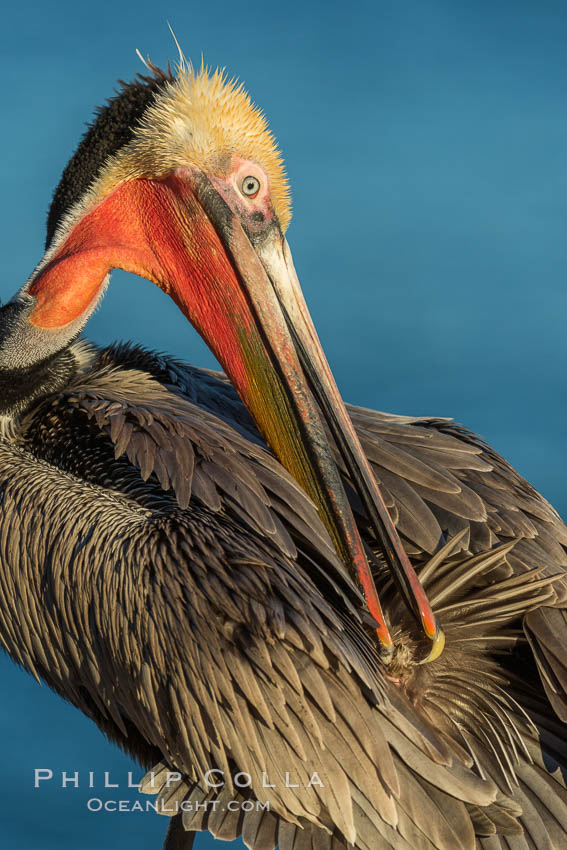
A brown pelican preening, reaching with its beak to the uropygial gland (preen gland) near the base of its tail. Preen oil from the uropygial gland is spread by the pelican's beak and back of its head to all other feathers on the pelican, helping to keep them water resistant and dry.
Image ID: 30289
Species: Brown pelican, Pelecanus occidentalis, Pelecanus occidentalis californicus
Location: La Jolla, California, USA
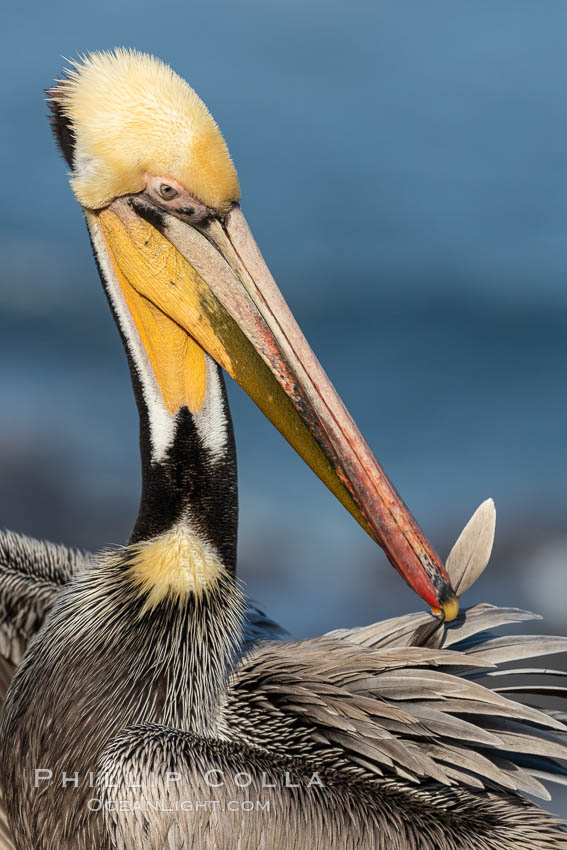
Yellow morph California brown pelican preening, cleaning its feathers after foraging on the ocean, with distinctive winter breeding plumage with distinctive dark brown nape, yellow head feathers. Note the unusual yellow gular throat pouch.
Image ID: 36681
Species: Brown pelican, Pelecanus occidentalis, Pelecanus occidentalis californicus
Location: La Jolla, California, USA
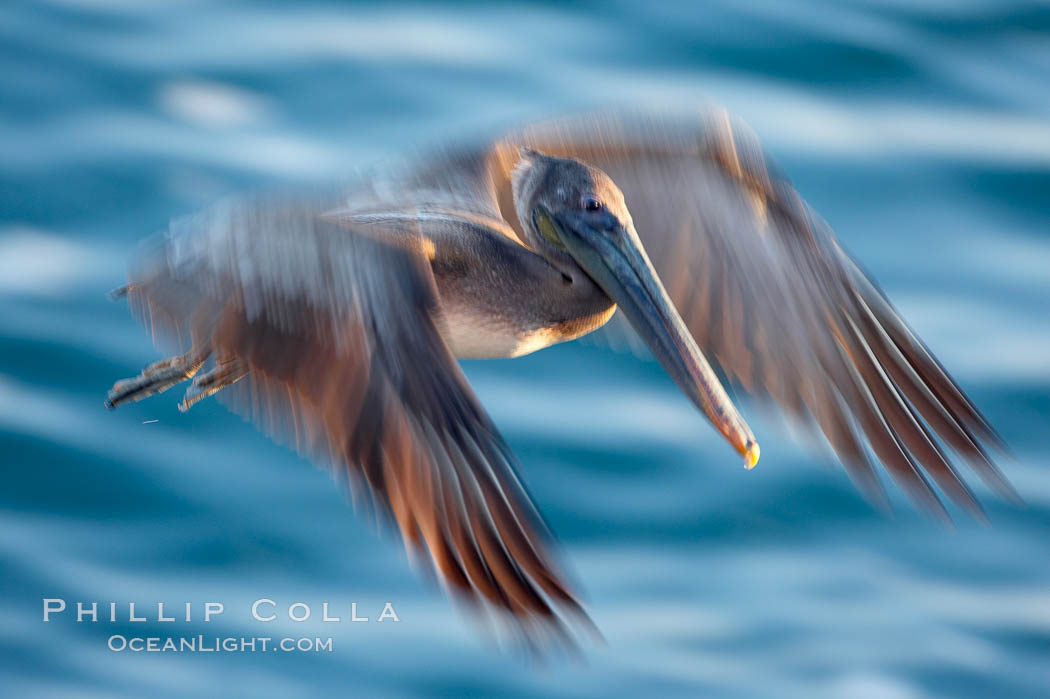
Brown pelican in flight. The wingspan of the brown pelican is over 7 feet wide. Long exposure shows motion as a blur. The California race of the brown pelican holds endangered species status. In winter months, breeding adults assume a dramatic plumage with dark brown hindneck and bright red gular throat pouch.
Image ID: 15136
Species: Brown pelican, Pelecanus occidentalis, Pelecanus occidentalis californicus
Location: La Jolla, California, USA
Socially, brown pelicans roost together (male and female) and fly in dramatic single file or V formations, hunting during the day. Brown pelicans often perform an odd behaviour known as a head-throw, in which they crank their large bill up and backward, stretching out the skin pouch and straightening their neck. It looks quite painful. Brown pelicans create low, broad nests in which the females will lay 2-3 eggs each year. (I have not observed nests atop the La Jolla cliffs, probably due to human presence, but have seen many nests in neighboring islands and coastal areas of Baja California just to the south.) In the 1960’s, brown pelican populations dropped precariously due to DDT and other toxic pesticides that reached the pelicans through coastal runoff that was then absorbed through the food chain by plankton and small teleost fishes. The DDT caused pelican eggs to be so thin that the young would not survive. (Other bird species were affected by DDT in the same way.)
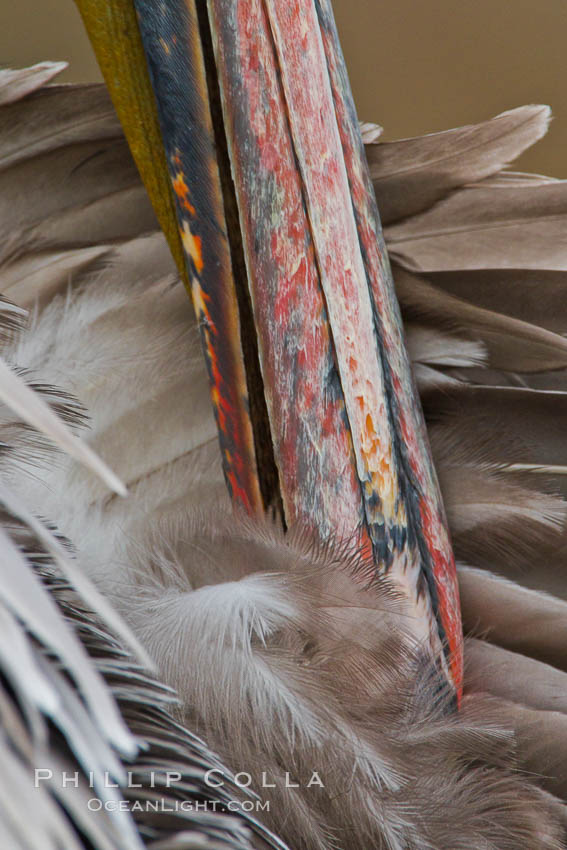
California brown pelican preening.
Image ID: 27261
Species: Brown pelican, Pelecanus occidentalis, Pelecanus occidentalis californicus
Location: La Jolla, California, USA
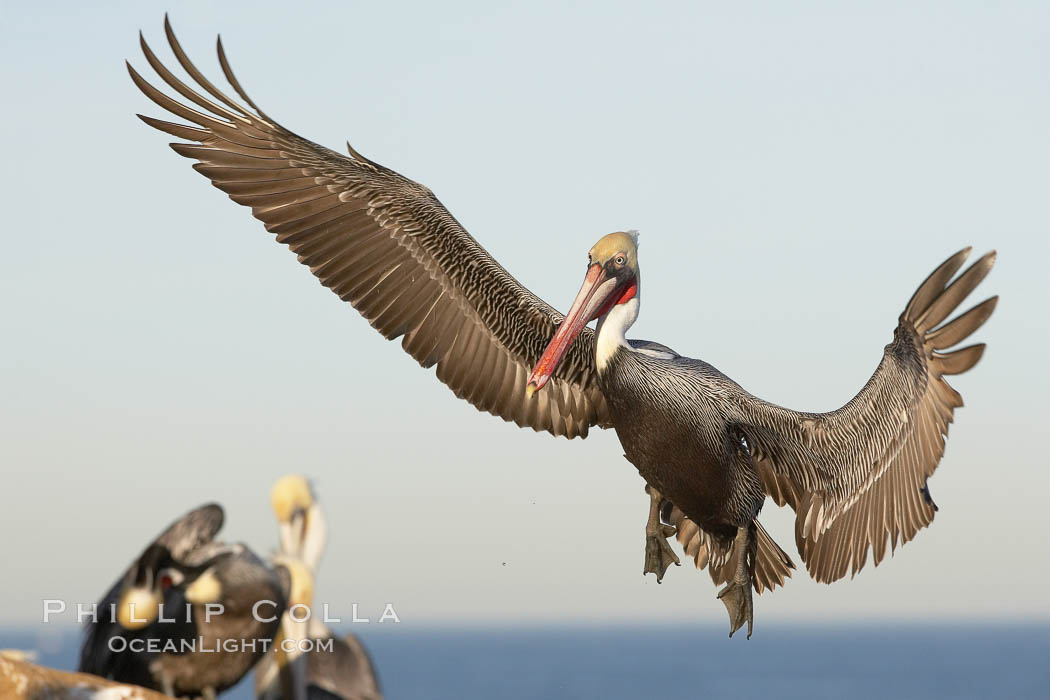
Brown pelican slows to land, spreading its large wings wide to brake.
Image ID: 20052
Species: Brown pelican, Pelecanus occidentalis, Pelecanus occidentalis californicus
Location: La Jolla, California, USA
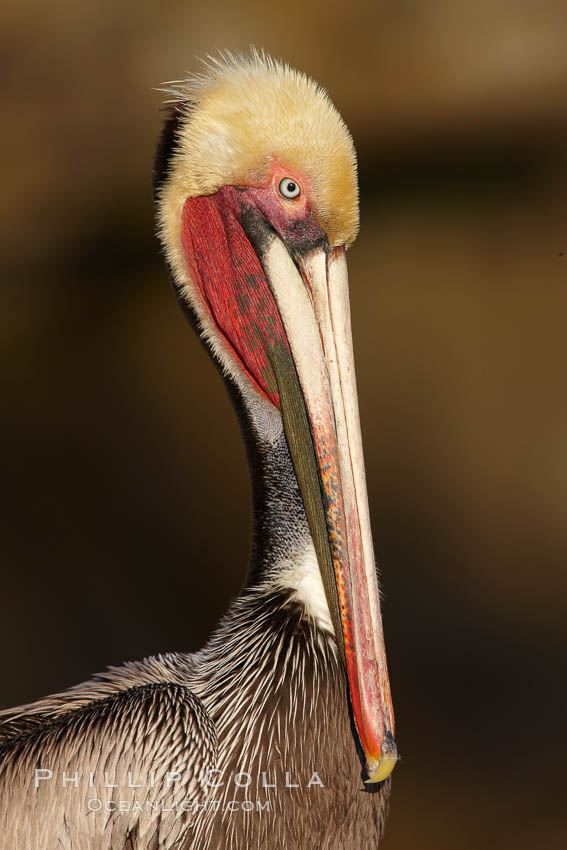
Brown pelican portrait, displaying winter breeding plumage with distinctive dark brown nape, yellow head feathers and red gular throat pouch.
Image ID: 22529
Species: Brown pelican, Pelecanus occidentalis, Pelecanus occidentalis californicus
Location: La Jolla, California, USA
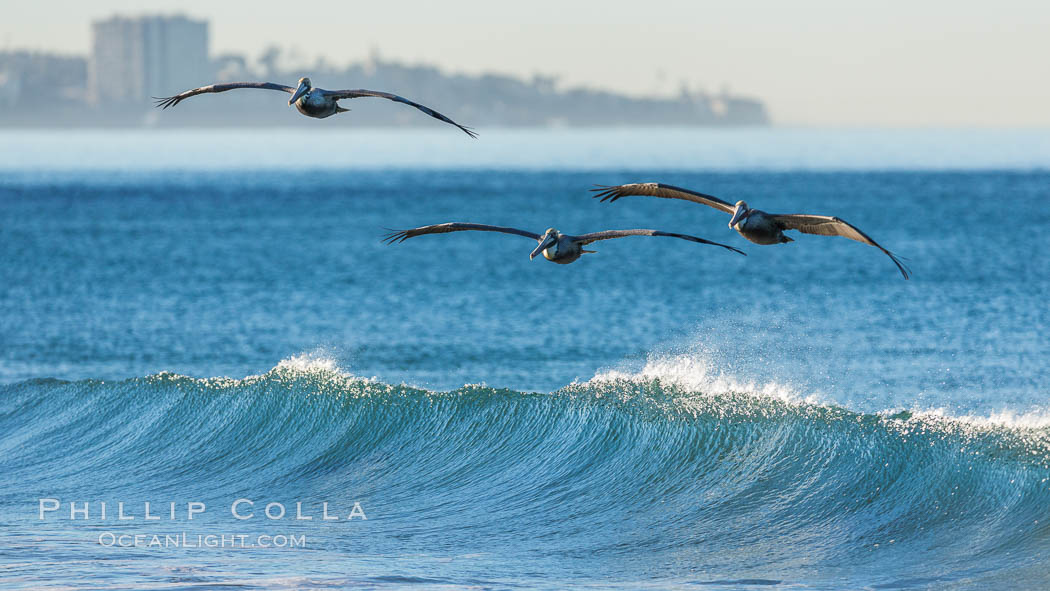
California Pelican flying on a wave, riding the updraft from the wave.
Image ID: 30262
Species: Brown pelican, Pelecanus occidentalis, Pelecanus occidentalis californicus
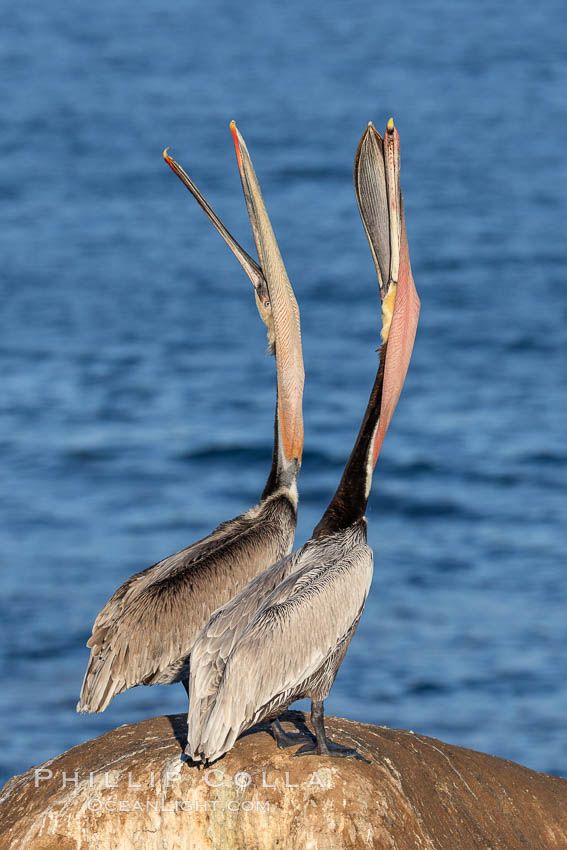
Two California Brown Pelicans performing a perfectly synchronous simultaneous head throw. Both display classic winter breeding plumage. Set against the Pacific Ocean.
Image ID: 37564
Species: Brown Pelican, Pelecanus occidentalis, Pelecanus occidentalis californicus
Location: La Jolla, California, USA



